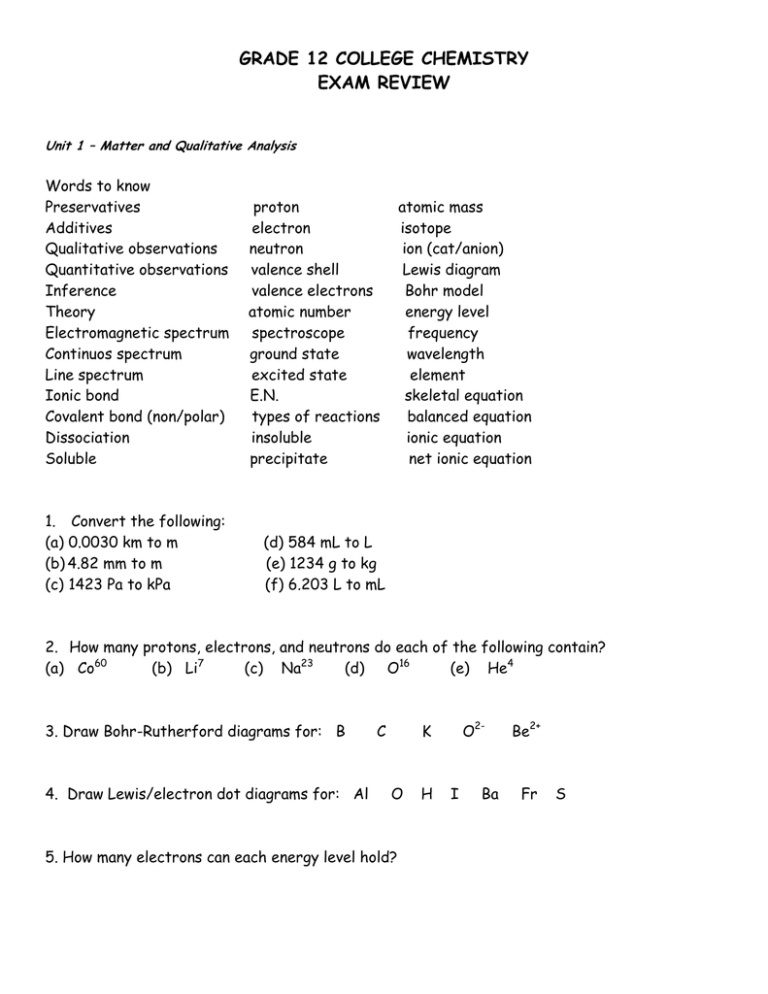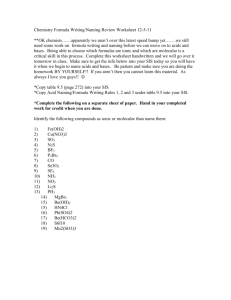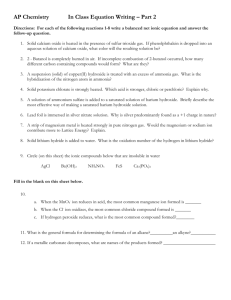GRADE 12 COLLEGE CHEMISTRY EXAM REVIEW
advertisement

GRADE 12 COLLEGE CHEMISTRY EXAM REVIEW Unit 1 – Matter and Qualitative Analysis Words to know Preservatives Additives Qualitative observations Quantitative observations Inference Theory Electromagnetic spectrum Continuos spectrum Line spectrum Ionic bond Covalent bond (non/polar) Dissociation Soluble 1. Convert the following: (a) 0.0030 km to m (b) 4.82 mm to m (c) 1423 Pa to kPa proton electron neutron valence shell valence electrons atomic number spectroscope ground state excited state E.N. types of reactions insoluble precipitate atomic mass isotope ion (cat/anion) Lewis diagram Bohr model energy level frequency wavelength element skeletal equation balanced equation ionic equation net ionic equation (d) 584 mL to L (e) 1234 g to kg (f) 6.203 L to mL 2. How many protons, electrons, and neutrons do each of the following contain? (a) Co60 (b) Li7 (c) Na23 (d) O16 (e) He4 3. Draw Bohr-Rutherford diagrams for: B 4. Draw Lewis/electron dot diagrams for: Al C O2- K O 5. How many electrons can each energy level hold? H I Ba Be2+ Fr S 6. Why do elements emit colour when heated? 7. (a) show the E.N. difference between the two elements (b) state whether they bond ionic, polar or nonpolar covalent (c) if ionic – show the transfer diagram, molecular formula, and its name (d) if covalent – Lewis formula, structural formula, and molecular formula (e) if polar covalent don’t forget to include ∂+ and ∂- Te and Cl Li and O C and Br 8. Write the chemical formula for the following: (a) potassium chloride (i) copper(I) phosphate (b) aluminum oxide (j) carbon dioxide (c) barium sulfate (k) lead (II) chlorate (d) carbon tetrachloride (l) barium cyanide (e) sodium acetate (m) lithium sulfide (f) ammonium hydroxide (n) dinitrogen pentoxide (g) magnesium fluoride (o) ozone (h) iron (III) carbonate (p) ammonia 9. Give the correct names for the following: (a) PbSO4 (i) HgCl2 (b) Fe(OH)3 (j) NaNO3 (c) CO (k) CuSO4 (d) H2O (l) CCl5 (e) N3Cl4 (m) MgS (f) Sn(ClO3)2 (n) Ba3(PO4)2 (g) CaCO3 (o) NH4CH3COO (h) KCN (p) SO3 10. Write word equations, balanced chemical equations, and state the type of reaction for: (a) Mercury (II) oxide is prepared from its elements (b) Aluminum metal reacts with Zinc (II) sulfate (c) Barium chloride reacts with sodium carbonate to produce barium carbonate and sodium chloride (d) Water is decomposed into hydrogen and oxygen gas 11. Balance the following and state the type of reaction observed: (a) K3PO4 (b) K (c) N2 + + + HCl KCl + H3PO4 NaNO3 Na + KNO3 O2 NO2 12. Precipitate reactions – Use the solubility table to: (a) write the balanced molecular equation (include if the products are soluble (aq) or insoluble (s) (b) write the ionic equation, and (c) the net ionic equation (if there is no reaction, write NR) Calcium chloride and ammonium hydroxide produces calcium hydroxide and ammonium chloride Lead (II) nitrate and sodium sulfide Ammonium carbonate and magnesium chloride Unit 2 – Chemical Calculations Words to know The mole Avogadro’s number Molar mass Mass n = m/MM solvent C = n/V 1. empirical formula molecular formula percentage composition stoichiometery mole ratio solution C1V1 = C2V2 limiting reagent excess reagent percentage yield concentration solute dilution 1 mole of bananas = ___________________________ bananas 2. 2.5 mole of pencils = __________________________ pencils 3. 8.75 x 1025 atoms of sodium = ___________________ mole Na 4. Calculate the molar mass of the following: (a) H2O (b) FeCl3 (c) O2 (d) NaNO3 (e) Ca(ClO3)2 5. Find the number of moles for the following compounds: (a) 100g of CaCO3 (c) 50g of C6H12O6 (b) 15.57g of Bi(OH)3 (d) 4.11 kg of K3PO4 6. Find the mass of the following (in grams): (a) 1 mol of HC2H3O2 (c) 2387 mol of Lithium hydroxide (b) 0.5 mol of Ca(ClO3)2 (d) 3.5 x 1027 molecules of NaCl 7. Calculate the percentage composition of each atom in: (a) KNO3 (b) H2O 8. Determine the empirical formula for a compound containing 80% C, and 20% H 9. Calculate the molecular formula for the following: (a) Molecular mass 400.5g ; Al = 20.2% Cl = 79.8% (b) Molecular mass 357g ; Sn = 66.4% C = 6.7% O = 26.9% 10. Consider the following reaction: 2H2 + O2 2H2O (a) How many moles of water can be produced by 6 moles of hydrogen? (use mole ratios) (b) How many moles of hydrogen are required if 5.5 moles of oxygen are used? 11. What mass of oxygen will react with nitrogen monoxide to form 3.68g of nitrogen dioxide? 12. How much ammonium hydroxide is needed to react completely with 75g of copper (I) nitrate in a double displacement reaction? 13. How many grams of CO2 will be produced when 8.50g of methane (CH4) reacts with 15.9g of oxygen gas? This is a limiting/excess reagent question. (10.9g) 14. A solution containing 5.0g of Na3PO4 is mixed with a solution containing 10.90g of Ba(NO3)2. If 7.69g of barium phosphate (actual yield) are recovered from the reaction, what is the percentage yield? (91.8%) 15. Calculate the concentration of a solution that contains 7.91 mol of solute in 2.53 L of solvent. 16. How many moles are contained in 750 mL of a 3.64 mol/L solution? 17. What is the mass of 3.96 L of a 0.628 M solution? 18. A solution contains 8.50 g of calcium chloride (CaCl2) dissolved in 3.33 L of water. What is the concentration of this solution? 19. Water is added to 0.20 L of 2.40 M NH3 cleaning solution until the final volume is 1.0 L. Find the new concentration of this diluted solution. Unit 3 – Organic Chemistry Words to know Hydrocarbon Alkane Alkene Alkyne Fractional distillation Cracking 1. functional group alcohol (hydroxy group) ether aldehyde (carbonyl group) ketone (carbonyl group) carboxylic acid (carboxyl group) ester organic solvent flammable combustible polymer un/saturated Name the following compounds: 2. Draw (any method) the following organic compounds: Propane methanol 2-pentene ethoxy hexane 3-octyne 2-pentanone butanal methyl propanoate ethanoic acid 2-butyne 3. Complete, balance, and name the following organic reactions. (don’t forget catalysts!) Unit 4 – Electrochemistry Words to know LEO says GER Redox Oxidation Reduction Oxidation numbers 1. activity series galvanic cells RED CAT and an OX electrolytic cell anode cathode primary cell salt bridge secondary cell electrolyte corrosion half-cell electroplating half-cell reactions electrorefining What is the oxidation number for the underlined element? H2 NaNO3 SO42- MgO HPO42- CO2 2. Use oxidation numbers to determine if the following are redox reactions. If it is, identify which element is oxidized and which is reduced. K H2 + + HCl + Na2CO3 O2 Na H2O + + K2CO3 H 2O NaHCO3 CO2 + NaCl 3. Use the activity series to determine if a reaction will occur: Cu + ZnSO4 Li + Pb(NO3)2 4. Draw a completely labeled galvanic cell using magnesium and silver electrodes. (include the anode, cathode half-cell reactions and the overall reaction) 5. Define corrosion and state the four factors that affect the rate of corrosion. 6. State two main differences between galvanic and electrolytic cells. Unit 5 – Chemistry in the Environment Words to know Hard water Soft water Acid Base Strong acid Weak acid 1. dilute concentration concentrated solution pH hydrogen ion conc. hydroxide ion conc. neutralization reaction titration volume (L) standard solution Boyle’s Law endpoint Charle’s Law Kinetic molecular theory Dalton’s Law Pressure (kPa) temperature (K) Draw a fully label a basic pH scale. 2. List three main properties of acids and bases. 3. What are the products of a neutralization reaction and show a typical reaction. 4. In an acid-base titration, 15.0 mL of carbonic acid H2CO3 were neutralized completely by 18.25 mL of 0.18 M potassium hydroxide. Calculate the concentration of the carbonic acid. (0.110 M) 5. What volume of 0.525 M HCl must combine exactly with 40.5 mL of an aqueous sodium hydroxide solution with a concentration of 0.375 M? 6. Outline the procedure (and all lab equipment) for performing an acid-base titration. 7. What is the final pressure of a 2.5 L gas that initially was at 122 kPa and 5.5 L? 7. Calculate the initial temperature of a 5.5 L gas that ends up with a volume of 7.2 L and a final temperature of 22 oC. 8. If a gas at standard pressure is added to another nonreactive gas at 35 kPa, what is the new pressure?





